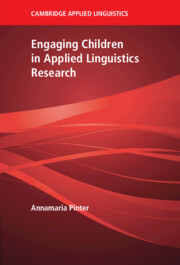
-
Select format
-
- Publisher:
- Cambridge University Press
- Publication date:
- October 2023
- October 2023
- ISBN:
- 9781009049078
- 9781316518069
- 9781009048873
- Dimensions:
- (229 x 152 mm)
- Weight & Pages:
- 0.63kg, 340 Pages
- Dimensions:
- (229 x 152 mm)
- Weight & Pages:
- 0.5kg, 340 Pages
- Series:
- Cambridge Applied Linguistics
- Subjects:
- Teacher training and professional development, Applied Linguistics, Education, Language and Linguistics
You may already have access via personal or institutional login- Series:
- Cambridge Applied Linguistics
- Subjects:
- Teacher training and professional development, Applied Linguistics, Education, Language and Linguistics
Book description
Who should speak for children in applied linguistics research? Should it be only adults, or is there room for children's perspectives and views as well? This pioneering book brings their voices to the forefront and shows that listening to children can open up new possibilities to conduct research with children rather than just on them. It covers a range of possibilities, from simply asking for children's perspectives to increasing levels of active participation, including adult-child partnerships as well as child-led research. Examples taken from the interdisciplinary literature illustrate what is feasible to achieve in different contexts, and both benefits and challenges are discussed, alongside the most pressing ethical dilemmas. A new, alternative framework for researching with children is promoted, which invites teachers and researchers to consider a wider range of roles that children can play, and encourages them to find their own opportunities when it comes to research involving children.
Awards
Winner, 2024 Book Award, British Association for Applied Linguistics
Reviews
‘I personally enjoyed reading it very much, and feel that teachers enrolled on a Trinity Diploma, MA programme or other graduate studies, and researchers working with children, will find the book very valuable. The two questions I started reading with were answered with clarity and, overall, this book will be a great addition to any library for organisations doing teacher training or research where children are involved.’
Gerhard Erasmus Source: IATEFL magazine
This is an inspiring book and one with the potential to influence a generation of research involving children.
Source: BAAL Book Prize Judge
Contents
Metrics
Altmetric attention score
Full text views
Full text views help Loading metrics...
Loading metrics...
* Views captured on Cambridge Core between #date#. This data will be updated every 24 hours.
Usage data cannot currently be displayed.
Accessibility standard: Unknown
Why this information is here
This section outlines the accessibility features of this content - including support for screen readers, full keyboard navigation and high-contrast display options. This may not be relevant for you.
Accessibility Information
Accessibility compliance for the PDF of this book is currently unknown and may be updated in the future.


